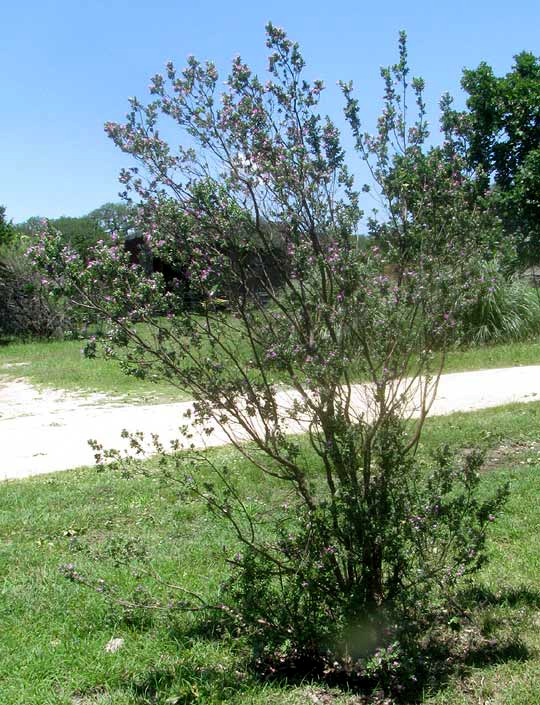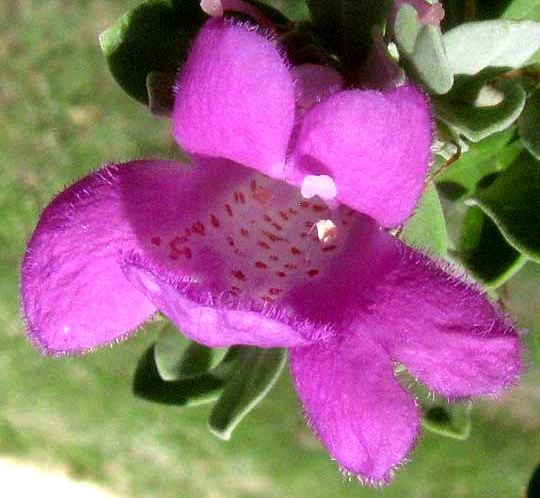Excerpts from Jim Conrad's
Naturalist Newsletter
from the June 16, 2013 Newsletter issued from the valley of the Dry Frio River in northern Uvalde County, southwestern Texas, on the southern border of the Edwards Plateau; elevation ~1750m (~5750 ft); N29.62°, W99.86°; USA
CENIZO/ "BAROMETER BUSH" FLOWERING
In front of the cabin there's a ten-ft-high (2m) shrub much branched from the base with somewhat spindly stems bearing smallish, silver leaves. This week the bush has produced pretty, magenta flowers, as shown below:

Blossoms crowded among branch-tip tufts of leaves can be seen below:

In that picture notice that the leaves are two-toned; their upper surfaces are greener than their more silvery lower surfaces. That feature helps distinguish this species from others. A close-up of a single flower appears below:

In that picture notice that the corolla displays bilateral symmetry, which means that there's only one plane across which you could cut the blossom so that each resulting half would be a mirror image of the other. Only certain plant families produce blossoms with bilateral symmetry -- with "zygomorphic" flowers, as we say -- so that's an important field mark. The blossoms, vaguely similar to snapdragon flowers, are about the size of a finger's last joint. You can see how nicely designed they are for bee pollinators.
The reason for the similarity with snapdragon flowers is that this bush or small tree is closely related to the snapdragons. Until recently they were both included in the Figwort Family, the Scrophulariaceae, but now, on the basis of DNA studies, snapdragons have been ejected from the family, while the tree in the front yard remains one of a few species remaining in the once large family.
The front-yard tree is commonly known by its Spanish name, Cenizo, but it's so abundant in some places and well regarded as a pretty shrub able to handle long periods of drought, that it's well known enough to go by several English names, including Barometer Bush, Texas Ranger, Texas Rain Sage, Texas Silverleaf, Ash-bush, Wild Lilac, and Purple Sage. It's LEUCOPHYLLUM FRUTESCENS, mostly found in arid northern Mexico, but entering the US in Texas, where mostly it shows up in the southwestern counties.
Two hours west of here, in the Rio Grande Valley at Del Rio, sometimes you see vast spreads of Cenizo. I've not found it growing wild here at the edge of the Edwards Plateau, but it does occur in the scrub of southern Uvalde County just to our south and lower in elevation. I can't say whether the one in front of the cabin is transplanted from the wild or is a horticultural cultivar. It might be the latter, because I'm used to seeing them paler, lower and wider than this one, but that's in more desert conditions.
Several cultivars of this fine shrub have been developed, graced with such names as 'Green Cloud', 'White Cloud', 'Compacta', 'Convent', and 'Bert-Star.'
Its names Barometer Plant and Texas Rain Sage reflect the local belief that the bush "knows" when it's about to rain and issues its flowers a few days in advance of a rain. The shrub in front of the cabin began flowering about a week ago. Last Sunday night we had the best rain of the year, over an inch, and this week we've enjoyed several showers, so this time our bush got it right.: